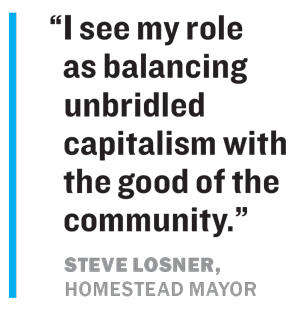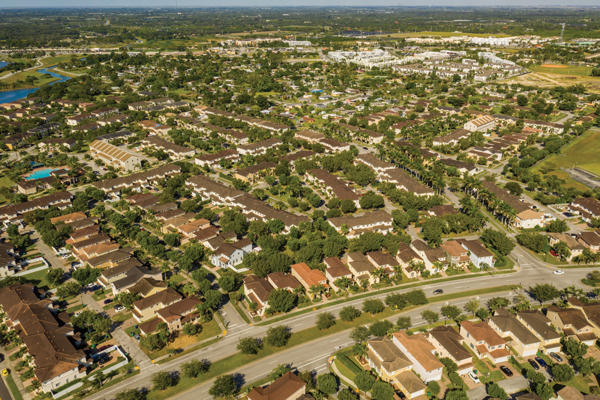Driving south from Miami on U.S. 1, rows of nearly identical single-family homes equidistant from each other start coming into view.
This is the city of Homestead, or the last frontier for home development in South Florida. With the Everglades to the west and the Atlantic Ocean to the east, it is essentially the only place in the tri-county area where there is developable land left to build new single-family homes. It is where developers like Lennar and DR Horton have been aggressively buying up hundreds of acres in the surrounding area to build new home communities.
Homestead’s new mayor, Steve Losner, is concerned about this massive build-up of cookie-cutter homes and is now proposing a moratorium on certain kinds of residential home development.
The showdown between the city and developers is likely to play out in years to come as South Florida faces a dire lack of single-family homes for the growing population. With the increased strain on municipal services and roadways, government officials in cities like Homestead are now worried that development has become unsustainable.
The moratorium
Homestead has had a rapid evolution, growing to more than 70,000 people today from just over 30,000 in 2000. To Mayor Losner, the biggest issue now is traffic, which is caused by the massive influx of residential development. Many of the city’s residents are commuters to Miami, which is about an hour away.
Losner said currently there is only enough vacant land to build 3,000 residential units, and it is his job to make sure that the development on the land provides a diversity of housing options.
“I see my role as balancing unbridled capitalism with the good of the community,” Losner said in an interview with The Real Deal.
 By early March, after workshop discussions with the city’s attorney and councilmembers, a consensus on the particulars of the potential moratorium became clear, according to the South Dade News Leader. Areas exempt from it would include northwest and southwest neighborhoods and the downtown area, in addition to any projects involving senior or affordable housing, commercial and industrial development and residential building of six units or less per acre. This would allow for basically any other type of development besides the type of housing that Lennar and DR Horton normally build.
By early March, after workshop discussions with the city’s attorney and councilmembers, a consensus on the particulars of the potential moratorium became clear, according to the South Dade News Leader. Areas exempt from it would include northwest and southwest neighborhoods and the downtown area, in addition to any projects involving senior or affordable housing, commercial and industrial development and residential building of six units or less per acre. This would allow for basically any other type of development besides the type of housing that Lennar and DR Horton normally build.
Neither Lennar nor DR Horton responded to requests for comment.
Losner argued that the new developments increase the demand and costs of municipal services, such as police and waste pick up. He also said that the city needs more higher-end housing to attract more businesses to the city.
“My goal is to bring some balance to the diversity of housing as well as having the cookie-cutter homes. We are saying, ‘Let’s slow down, and let’s look at what else is left and what is the mix of housing,’” Losner said.
Going at Goliath
Losner and other city officials are pitting themselves against some of the largest real estate companies in the country, who have acquired hundreds of acres of land around Homestead and elsewhere in south Miami-Dade County.
Why the land grabs? Two reasons: There are limited housing options in Florida, and demand for single-family homes that are reasonably affordable is sky-high, according to Ralph McLaughlin, chief economist and senior vice president of analytics at Haus.
“Housing inventory in Florida is near historic lows,” McLaughlin said. “There are slim pickings for someone picking a single-family home.”
In February 2020, the average home closing price in Homestead was $245,000, according to Redfin. That’s lower than the Miami-Dade County average closing price over the same period of $322,000.
Affordability has been the driver for larger builders into Homestead. For its Riviera home community, Lennar spent $10.75 million in 2017 for about 77 acres just west of the Turnpike along Mowry Drive and Southwest 152nd Avenue. Then in August 2019, Lennar paid $22.1 million for roughly 85 acres in Homestead zoned for 770 residences.
Miami-based Lennar is a homebuilding machine with a 2019 revenue of over $7 billion. It delivered more than 16,420 homes around the country in the fourth quarter of 2019. The company, known for its “Everything’s Included” model, aims to provide reasonably priced homes with simple designs.
Some local homebuilders have avoided Homestead due to the presence of competitors like Lennar.
“In 25 years we have never built down south,” said Coral Gables-based Century Homebuilders’ Sergio Pino. “I have been down there so many times, and I can’t make the numbers work.”
Pino, whose company has built 15,000 homes, focuses on building in west Miami-Dade County near Westchester. He said traffic is not as bad in western part of the county and property costs are cheaper.
“I can build 10 homes in West Dade for what it would be to do 50 homes down south,” Pino said. “The profit margins [in south Miami-Dade County] are very tight.”
An ominous future?
Homestead was the epicenter of two of South Florida’s most devastating events in the last 30 years. The city was nearly wiped out by Hurricane Andrew in 1992 where the Category 5 storm made landfall. And during the housing collapse about a decade ago, it was the real estate market hit hardest throughout South Florida.
Almost nine out of every 10 sales in Homestead were distressed in 2009, according to a report at the time by the Miami Herald. This was far more than the rest of South Florida where the number was around 60 percent.
With a global recession looming from the fallout of the novel coronavirus, how will South Florida’s housing market fare this time? Over 10 percent of Homestead homeowners owe more than their home is worth, while the average for South Florida is 7.2 percent, according to Zillow.
During the last recession, the property values plummeted in Homestead as borrowers turned delinquent on their mortgages. The city could face some these same issues soon, according to Jack McCabe of McCabe Research & Consulting.
“They went into the last go-around where such a large percentage of homes went into foreclosure, it just drags everything down,” McCabe said. “It went from a checkered reputation [to one] that is becoming more attractive, and it could take another 10 years to pick up again.”
